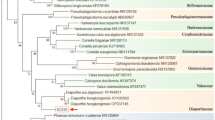Abstract
The herbicidal mechanism of the components extracted from Pythium aphanidermatum was examined in this study. Component I was isolated using the HPD500 macroporous adsorption resin and HPLC. Its impact on seed germination and plant growth of weeds was determined and the contents of MDA, superoxide anion radical, and the activities of hills and roots were examined. The root length of weed plants was inhibited under illumination while the stem height was inhibited evidently under darkness. The relative electric conductivity of Digitaria sanguinalis and Amaranthus retroflexus under illumination was 94.55 μS·cm−1 and 58.75 μS·cm−1, respectively, whereas that under darkness was 85.25 μS·cm−1 and 36.25 μS·cm−1, respectively. The MDA contents of Digitaria sanguinalis and Chlorella pyrenoidosa were 0.08385 μmol·L−1 and 0.1742 μmol·L−1 under illumination, respectively, while those were 0.0129 μmol·L−1 and 0.01935 μmol·L−1 under darkness, respectively. Simultaneously, superoxide anion radical content was higher under illumination than under darkness. These results showed the photosynthesis was affected by component I extracted from Pythium aphanidermatum.
Similar content being viewed by others
References
Arnon D I (1949). Copper enzymes in isolated chloroplast polypheno-loxidase in Beta vulgaris. Plant Physiology, 24(1): 1–15
Chen W, Xue Z X (1995). Research and Development of New Pesticides. Beijing: Chemical Industry Press, 16–65 (in Chinese)
Crossmann K, Berghaus R, Petzlaff G (1992). Heterotrophic plant cell suspension cultures for monitoring biological activity in agrochemical research. Pesticide Science, 35(3): 83–289
Delorenzo M E, Scott G I, Ross P E (2001). Toxicity of pesticides to aquatic microorganisms. Environmental Toxicology and Chemistry, 20(1): 4-98
Dong J G, Fan M Z, Han J M, Liu S H, Cao L H (1999). The effect of AB toxin from Alternaria brassicae on membrane permeability and the activities of SOD and POD in cell of Chinese cabbage leaves. Acta Phytopathologica Sinica, 29(2): 38–141 (in Chinese)
Huang K (2007). Study on methods and mechanism for removal nitrogen and phosphorus in wastewater by algae. Dissertation for the Masteral Degree. Nanchang: Nanchang University, 17–19 (in Chinese)
Jiang S J, Qiang S, Zhu Y Z (2006). Isolation, purification, identification, and bioassay of helminthosporin with herbicidal activity from Curvularia eragrostidis. Journal of Plant Protection, 33(3): 13–318 (in Chinese)
Mallory S C A, Retzinger E J (2003). Revised classification of herbicides by site of action for weed resistance management strategies. Weed Technology, 17(3): 05–619
Peng H, He H W (2003). The advances in research of inhibitor of carotenoid biosynthesis. Chinese Journal of Pesticide Science, 5(4): 1–8 (in Chinese)
Shen G X, Yan G A, Peng J L, Yan X (1999). Study on ecotoxicology for pesticides to algae II: toxic mechanism and accumulation, degradation. Techniques and Equipment for Enviromental Pollution Control, 7(6): 31–139 (in Chinese)
Su S Q (1998). Classification of herbicides by target of action and herbicides use. Pesticides, 37(11): 1–7 (in Chinese)
Tang Z C, Wei J M, Chen Y (2004). Modern Guide to Plant Physiology Experiments. Beijing: Science Press, 107–109 (in Chinese)
Wakabayashi K, Boger P (2002). Target sites for herbicides: entering the 21st century. Pest Management Science, 58(11): 149–1154
Wang A G, Luo G H (1990). Quantitative relation between the reaction of hydroxylamine and superoxidee anion radicals in plants. Plant Physiology Communications, 26(6): 5–57 (in Chinese)
Wu Y C, Hu F Z, Yang H Z (2001). Research development on the inhibitors of 4-hydroxyphenylpyruvate dioxygenase. Chinese Journal of Pesticide Science, (3): 1–10 (in Chinese)
Zhang J L (2005). Structural identification of herbicidal toxin fractions produced and DDRT analysis of mutant isolates of Pythium aphanidermatum. Dissertation for the Doctoral Degree. Baoding: Agricultural University of Hebei, 18 (in Chinese)
Zhang J L, Xu K, Li C, Ma J, Dong J G (2005). The bioactivity of mutant isolates from Botrytis cinerea. Scientia Agricultura Sinica, 38(6): 174–1181 (in Chinese)
Zhang R S (1999). Recent herbicide targets and new challenges. World Pesticide, 21(1): 0–61 (in Chinese)
Zhao S J (1999). Modern Guide to Plant Physiology Experiments. Beijing: Science Press, 305–306 (in Chinese)
Zhou Y H, Miao W R, Cheng L B (2002). Progress on protoporphyrinogen oxidase-inhibiting herbicides. Chinese Journal of Pesticide Science, 4(1): 1–8 (in Chinese)
Author information
Authors and Affiliations
Corresponding author
About this article
Cite this article
Xu, J., Xu, W., Zhang, L. et al. Mechanism of herbicidal action of the component I from Pythium aphanidermatum . Front. Agric. China 3, 171–177 (2009). https://doi.org/10.1007/s11703-009-0043-9
Received:
Accepted:
Published:
Issue Date:
DOI: https://doi.org/10.1007/s11703-009-0043-9




